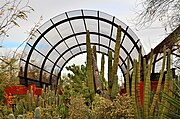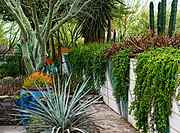Desert Botanical Garden
| Desert Botanical Garden | |
|---|---|
 Desert Botanical Garden | |
| Location | Phoenix, Arizona, US |
| Coordinates | 33°27′43″N 111°56′41″W / 33.46194°N 111.94472°W |
| Area | 140 acres (57 ha) |
| Established | 1939 |
| Founder | Arizona Cactus and Native Flora Society |
| Habitats | |
| Plants | 50,000 |
| Species | 4,379 |
| Collections |
|
| Website | dbg |
Desert Botanical Garden is a 140-acre (57 ha) botanical garden located in Papago Park, at 1201 N. Galvin Parkway in Phoenix, central Arizona.
Founded by the Arizona Cactus and Native Flora Society in 1937[1] and established at this site in 1939, the garden now has more than 50,000 plants in more than 4,000 taxa, one-third of which are native to the area, including 379 species which are rare, threatened or endangered.
Of special note are the rich collections of agave (4,026 plants in 248 taxa) and cacti (13,973 plants in 1,320 taxa), especially the Opuntia sub-family. Plants from less extreme climate conditions are protected under shadehouses. It focuses on plants adapted to desert conditions, including an Australian collection, a Baja California collection and a South American collection. Several ecosystems are represented: a mesquite bosque, semi-desert grassland, and upland chaparral.
Desert Botanical Garden has been designated as a Phoenix Point of Pride.[2]
History
[edit]In the 1930s, a small group of local citizens became interested in conserving the fragile desert environment. One was Swedish botanist Gustaf Starck, who found like-minded residents by posting a sign, "Save the desert", with an arrow pointing to his home. In April 1934 they formed the Arizona Cactus and Native Flora Society (ACNFS) to sponsor a botanical garden to encourage an understanding, appreciation and promotion of the uniqueness of the world's deserts, particularly the local Sonoran Desert.[3]
Eventually Gertrude Webster, whose home encompassed all of what is today the neighborhood of Arcadia, joined the Society. She offered her encouragement, connections and financial support to establish the botanical garden in Papago Park. Margaret Bell Douglas provided support as well, donating 1,500 specimens to the herbarium.[4]
Webster served as president of the Society's first Board of Directors and Gustaf Starck, W. E. Walker, Rell Hasket, L. L. Kreigbaum, and Samuel Wilson were the five vice president. The latter also served as Treasurer. Paul G. Olsen was Secretary. In 1938, after much work by the ACNFS, the board hired the Garden's first executive director, George Lindsay, who oversaw the first planting on the grounds. The Desert Botanical Garden opened in 1939 as a non-profit museum dedicated to research, education, conservation and display of desert plants.
Education and art
[edit]The Garden offers specialized tours, workshops and lectures on desert landscaping and horticulture, nature art and photography, health and wellness.[2]
The Garden presents Spring and Fall open-air acoustic concert series, art exhibitions, and Las Noches de las Luminarias since 1978. The Luminarias Festival became a Southwestern Holiday tradition featuring live music by the flickering lights of 8000 hand-lit luminaria.[5]
Volunteerism
[edit]Volunteers were essential in the Garden's creation and development, when the staff was small and finances tight. These early supporters, including a few amateur botanists who donated their own plant collections, helped plan and execute plant sales, photography and art exhibits, and numerous public events.
Volunteers remain a Garden asset, sharing their time, talents and professional expertise. They work closely with staff to maintain the Garden's status as a premier plant research institution and serve as members of the Board of Trustees, setting policy and governing the Garden.
Gallery
[edit]-
Desert Botanical Garden
-
Different species of cacti on display in the Desert Botanical Garden of Phoenix
-
Webster Auditorium
-
The Webster Auditorium building was constructed in 1939 and is located inside the compounds of the Desert Botanical Garden. In 1937, Gertrude Webster joined newly established Arizona Cactus and Native Flora Society. The auditorium is named after her. In 1990, the National Park Service certified Webster Auditorium as a national historic site and assigned it the reference number 9000823.
-
Inside the historic Webster Auditorium. The auditorium was listed in the National Register of Historic Places on May 1, 1990, ref: 9000823.
-
Parkinsonia microphylla at the Desert Botanical Garden
-
Cactus display
-
Yucca rostrata (beaked yucca)
-
Pachycormus discolor (elephant tree)
-
The Weisz Family Plaza
-
Justicia californica
-
Cacti and succulents display
-
Butterfly pavilion
-
Cactus flowers
-
There is a great variety of cacti at the Desert Botanical Garden.
-
Wildflower garden
See also
[edit]- List of botanical gardens and arboretums in Arizona
- List of historic properties in Phoenix, Arizona
- List of botanical gardens in the United States
References
[edit]- ^ Deborah A. Starr, "Desert Botanical Garden", Horticulture, March 1994:48–54.
- ^ a b "Phoenix Points of Pride". Archived from the original on October 1, 2006. Retrieved October 18, 2006.
- ^ Rhys Lee A shining beacon of conservation: The Desert Botanical Garden Archived 2019-10-04 at the Wayback Machine Arcadia News Oct 1, 2019
- ^ "Margaret Bell Douglas". AWHF. Archived from the original on September 25, 2020. Retrieved May 15, 2019.
- ^ "History of Las Noches de las Luminarias". Desert Botanical Garden. November 30, 2021. Archived from the original on May 15, 2022. Retrieved May 15, 2022.
External links
[edit]- Official Desert Botanical Garden website
 Geographic data related to Desert Botanical Garden at OpenStreetMap
Geographic data related to Desert Botanical Garden at OpenStreetMap


















